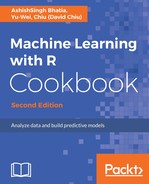Survival analysis is also known as duration analysis, transition analysis, failure time analysis, and time-to-event analysis. In survival analysis, subjects are tracked until an event happens or we lose them from the sample. Events can be anything, such as death, marriage, divorce, and so on. Subjects are followed for a specific time and the focus is on the time the event occurs. The three terms used commonly while talking about survival analysis are birth event, death event, and censorship. A birth event is the time when the observation started, a death event is the time at the end of the event or study, and censorship means a death event will not always occur. Censoring occurs because the subject does not experience the event during the time, the subject is lost, or the subject withdraws from the study. Censoring can be thought of as a kind of missing data problem. Consider the study of a clinical trial being conducted for 2 years; if the person under observation does not show any symptoms during that period, it is said to be censored, or some patient leaves the trial before the said period then that case is also categorized as censored.
Censoring can be categorized as right censoring and left censoring. Right censoring means a subject leaves before the event occurs or the study ends before the event occurred. For example, in clinical trial for 2 years of disease A is conducted. Patients who do not have disease A in 2 years are censored. Left censoring means the event of interest has already occurred before the patient is taken in under observation. It is normally a rare case. Again, right censoring can be of two types: Type 1: Random dropout and Type 2: End of a study when the fixed or predetermined event has occurred. A response from the observations is normally referred as failure time, survival time, or event time. Survival analysis is widely used in medical or clinical trial fields to record the result and predict the outcome. Let's understand it with a few examples. Assume a medical or clinical trial is conducted to determine whether a particular treatment, say treatment A, is effective or not in, say, disease B. The study or trial is carried out with some patients under observation and records the patient response to treatment A. It studies whether the patient survives or not or leaves the study in between for some reason. Another example concerns a loan performance: if a borrower will repay the loan in time or will default. In terms of commerce or online shopping, the study time is between signup and the first order. It can also be used to study the market to determine how long it takes a person to replace his or her phone, the time until the machine part fails, Survival analysis is a type of regression model but the point of interest is to find the dropout, where the subjects under observation are not sure about the event.
The survival function S(t) is the probability that the subject survives longer than time t:
Here t is some time, T is a random variable denoting the time of death, Pr is the probability. S(0) = 1. The survival function approaches 0 as time increases. In theoretical terms, the survival function is smooth; that is, it is represented by the smooth curve. In practice, it may differ as the events are observed on a discrete time scale. One must also get accustomed to the hazard function and cumulative hazard function which are used to describe the rate at which an event occurs. For more details, visit https://en.wikipedia.org/wiki/Survival_analysis#Definitions_of_common_terms_in_survival_analysis.
